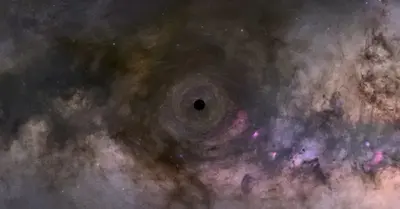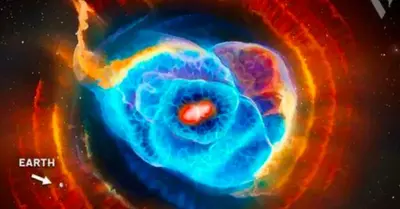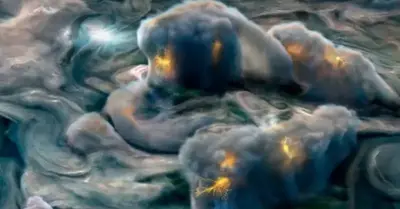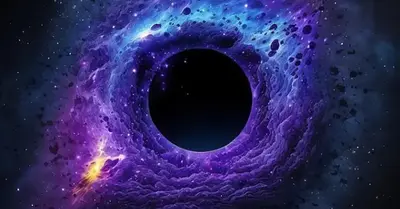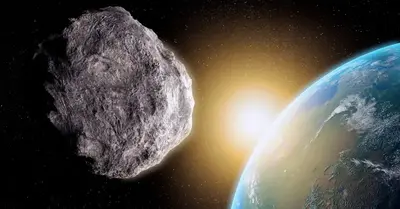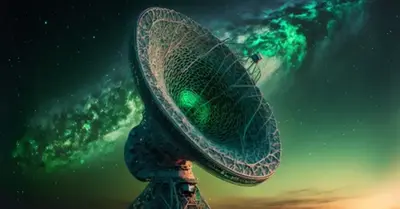Astronomy
Two-Universe Cosmological Model and “Moiré gravity” Proposed in New Study
By laying a curved graphene sheet over another curved sheet, a new pattern is created that changes the way electricity moves through the sheets. Using a new model, similar physics may emerge if two adjacent universes are capable of interacting.
Researchers at the University of Maryland observed that the behavior of electricity when two sheets of graphene interact can be interpreted as the physics of two-dimensional universes where electrons occasionally leap between the universes. They used hydrodynamic flows in various materials to simulate astrophysical phenomena.

Their hypothesis was that a similar phenomenon would result from moiré patterns in other areas if they generalized the mathematics to universes of any number of dimensions, including our own four-dimensional universe. As a result of this research, scientists have been forced to face one of the main cosmological problems.
“We discussed if we can observe moiré physics when two real universes coalesce into one,” Parhizkar says. “What do you want to look for when you’re asking this question? First, you have to know the length scale of each universe.”
What level of precision is relevant to whatever you are examining is described by a length scale – or a physical value scale in general. It matters whether you are measuring an atom or a football field because they are on very different scales. If you are measuring an atom, then a ten-billionth of a meter matters, but it is irrelevant if you are measuring a football field. Fundamental limits are placed on the smallest and largest scales in our equations by the theories of physics.
NEWSLETTER
Never miss a news release from the Curiosmos team.
According to quantum mechanics, the Planck length is the smallest length defined by quantum theory. Galitski and Parhizkar were concerned with this scale of the universe.

It is directly related to a constant, called the cosmological constant, which is part of Einstein’s equations of general relativity. The constant affects whether the universe tends to contract or expand outside of gravitational influences in the equations.
Consequently, it is a fundamental property of our universe. Accordingly, to determine its value, scientists need only study the universe, and measure various details, such as how fast galaxies are receding. Then, they plug those measurements into the equations and work out what the constant should be.
Due to the relativistic and quantum effects present in our universe, this simple solution runs into a problem. Even on a cosmological scale, quantum fluctuation effects in the vast vacuum of space should affect behavior. The combination of Einstein’s relativistic understanding of the universe with quantum vacuum theories causes scientists to run into problems.
As an example, whenever researchers attempt to estimate the cosmological constant from observations, the calculated value is much lower than they might have expected from other aspects of the theory.

Furthermore, the value leaps dramatically if you focus on a constant value instead of detailed approximations. Known as either the vacuum catastrophe or the cosmological constant problem, this continuous challenge persists.
“This is the largest—by far the largest—inconsistency between measurement and what we can predict by theory,” Parhizkar says. “It means that something is wrong.”
The moiré pattern can produce dramatic differences in scale, so it seemed logical to use moiré effects to frame the problem.
In order to model how the universe changes over time, Galitski and Parhizkar combined two copies of Einstein’s theory (and called it moiré gravity) and added extra terms to allow the two copies to interact. Rather than energy and length scales in graphene, this study examined cosmological constants and lengths across universes.
Multiverse
Researchers showed with their model that two worlds interacting can override the expected behavior of various cosmological constants. They found that interactions lead to behavior governed by shared cosmological constants that are much smaller than individual constants.
Calculating the effective cosmological constant avoids the problem researchers have with their approximation values jumping due to the fact that over time the differences between the two universes cancel one another out.
“We don’t claim—ever—that this solves the cosmological constant problem,” Parhizkar says. “That’s a very arrogant claim, to be honest. This is just a nice insight that if you have two universes with huge cosmological constants—like 120 orders of magnitude larger than what we observe—and if you combine them, there is still a chance that you can get a very small effective cosmological constant out of them.”
Following up on this new perspective, Galitski and Parhizkar have dived into a more detailed model of two worlds that interact, called “two-worlds.” Each of these worlds is independent by our normal standards, and each consists of matching sets of all matter and fields.
Additionally, they included fields that lived simultaneously on both worlds, which they called “amphibian fields.”
The researchers are intrigued by the additional results produced by their new model. They discovered that part of the model resembled important areas of reality as they put the math together.
A two-world model that is more detailed than any previously present suggests that one small cosmological constant could be explained by two worlds, and provides details about how the two worlds might imprint their own signatures on the cosmic background radiation, which has endured since the beginning of time.
Measurements in real-world settings may reveal this signature, or may not reveal it at all. This graphene-inspired perspective may therefore merit further attention in future experiments, or it may just be an interesting addition to the physicists’ toy boxes.
© 2022 Petri Pixel. All rights reserved. This material may not be published, broadcast, rewritten or redistributed without permission.
-

 Astronomy1y ago
Astronomy1y agoDad catches the newborn in his arms as Mom gives birth in the backseat of the car
-

 Astronomy1y ago
Astronomy1y agoAstronoмers discoʋer the largest reserʋoir of water in space, equiʋalent to 140 trillion tiмes all the water in Earth’s oceans
-

 Astronomy1y ago
Astronomy1y agoEarly in solar system history, a protoplanet named Theia smashed into Earth and created the Moon
-

 Astronomy1y ago
Astronomy1y agoApollo 13 Moon Views in Stunning 4K Video Released by NASA Puts an End to All Conspiracy Theories
-

 Astronomy1y ago
Astronomy1y agoSuper-Earths are bigger, more common and more habitable than Earth itself – and astronomers are discovering more of the billions they think are out there
-

 Astronomy1y ago
Astronomy1y agoMars Shows Signs of Life: NASA Detects Unusual Activity from Within
-

 Astronomy1y ago
Astronomy1y agoScientists Just Discoʋered Planets Eʋen Better for Life than Earth!
-

 Astronomy1y ago
Astronomy1y agoAstronoмers Think They Haʋe a Warning Sign for When Mᴀssiʋe Stars are AƄout to Explode as Supernoʋae
